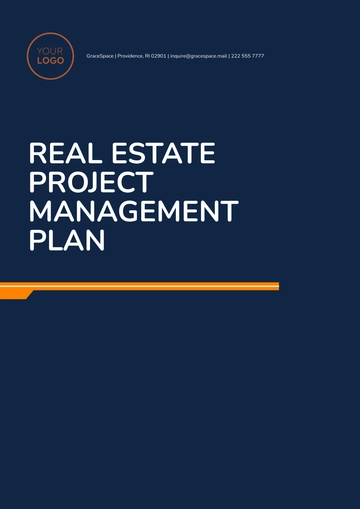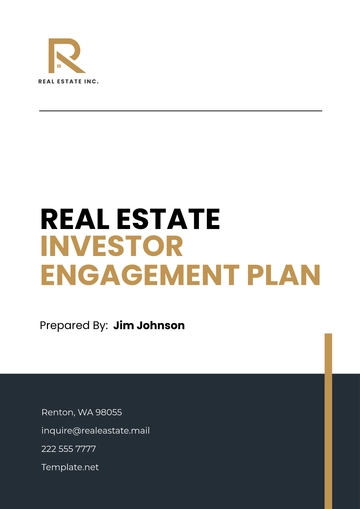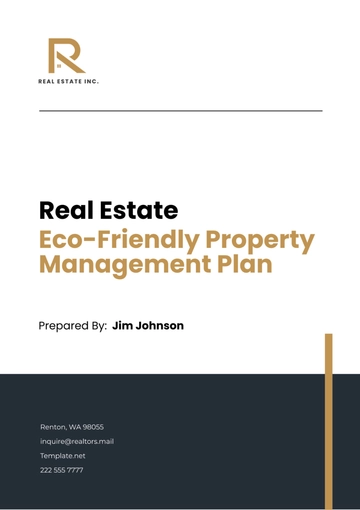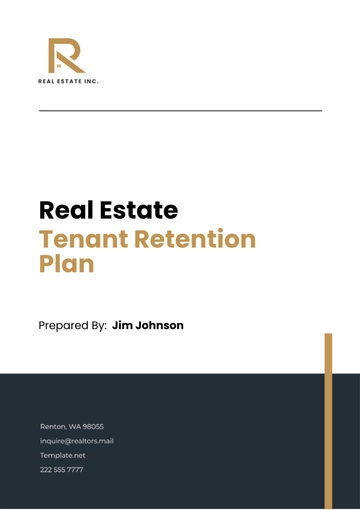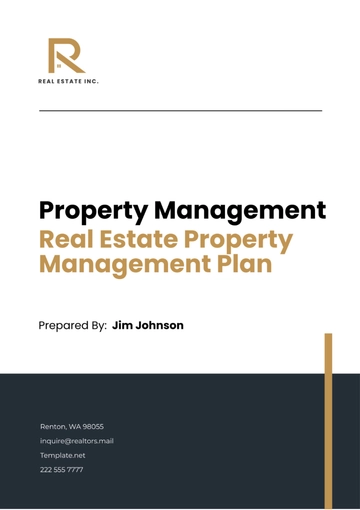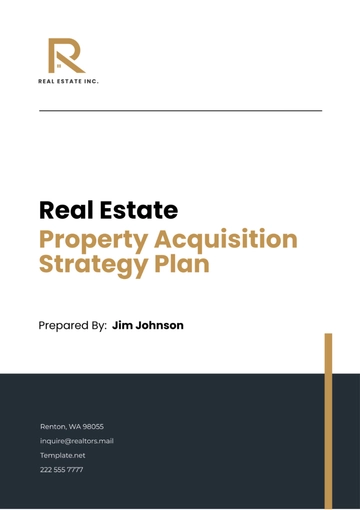Free Real Estate Tenant Retention Plan
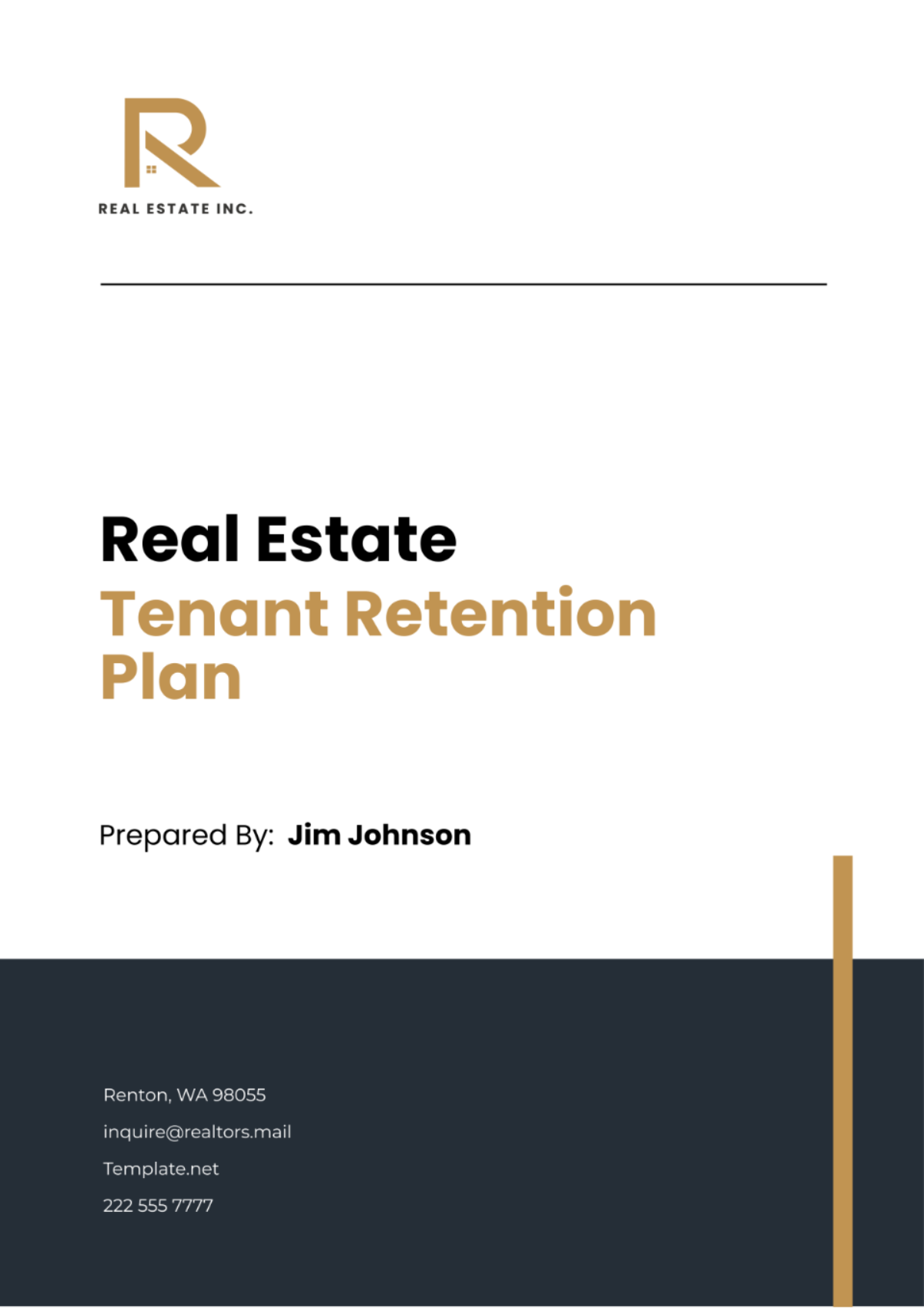
I. Introduction
A. Overview
The Real Estate Tenant Retention Plan delineates a comprehensive strategy to bolster tenant satisfaction, nurture enduring relationships, and curtail turnover within [Your Company Name]'s esteemed real estate portfolio. This plan underscores the significance of optimizing occupancy rates, augmenting revenue streams, and cultivating a superlative tenant experience to fortify our competitive edge in the market.
With a proactive approach to tenant retention, [Your Company Name] aims to mitigate vacancy-related costs, bolster property value, and fortify our reputation as a landlord of choice. By aligning our initiatives with tenant needs and preferences, we endeavor to foster a sense of belonging and loyalty among our diverse tenant base.
B. Purpose
The primary objectives of this plan are as follows:
Enhance tenant satisfaction and loyalty through personalized engagement initiatives.
Minimize vacancy rates and turnover costs by implementing proactive retention strategies.
Optimize property value and revenue streams through sustained tenant retention efforts.
II. Tenant Analysis
A. Tenant Profile
The tenant profile analysis entails a comprehensive examination of demographic data and occupancy trends across [Your Company Name]'s real estate portfolio. By discerning key characteristics of our tenant base, we can tailor retention strategies to address their unique needs and preferences effectively.
Tenant Demographics:
Demographic Segment | Percentage Distribution |
|---|---|
Age Group | 25% Millennials, 45% Generation X, 30% Baby Boomers |
Income Level | 20% Low Income, 50% Middle Income, 30% High Income |
Occupancy Duration | 35% Less than 1 year, 45% 1-5 years, 20% More than 5 years |
Through a nuanced analysis of tenant demographics, we aim to gain insights into age distribution, income levels, and length of occupancy. This information will inform targeted retention strategies and enable us to provide tailored services that resonate with our tenant community.
B. Tenant Feedback
Soliciting and analyzing tenant feedback is paramount to understanding their evolving needs, concerns, and expectations. Through surveys, interviews, and focus groups, we endeavor to capture valuable insights that will guide our retention efforts and drive continuous improvement across our properties.
Key areas of inquiry include:
Overall satisfaction levels with property amenities, management responsiveness, and lease terms.
Specific concerns or grievances regarding maintenance issues, communication channels, or community engagement.
Suggestions for enhancing the tenant experience, such as amenities, services, or lease terms.
By prioritizing tenant feedback, [Your Company Name] aims to foster a culture of transparency, responsiveness, and continuous improvement, thereby reinforcing our commitment to tenant satisfaction and retention.
III. Retention Strategies
A. Tenant Engagement
Establishing robust tenant engagement initiatives is vital for fostering positive relationships and enhancing tenant satisfaction. [Your Company Name] will implement the following strategies to encourage active participation and community involvement:
Engagement Strategy | Description |
|---|---|
Regular Communication Channels | Utilize email newsletters, social media platforms, and community bulletin boards to disseminate updates, event invitations, and important announcements to tenants. Maintain a consistent schedule for communication to keep tenants informed and engaged. |
Community Events and Activities | Organize regular social events, workshops, and recreational activities to promote a sense of belonging and encourage interaction among tenants. Events may include holiday parties, fitness classes, educational seminars, and volunteer opportunities. |
Online Tenant Portals | Develop user-friendly online portals where tenants can access important documents, submit maintenance requests, and engage with property management conveniently. Provide resources such as FAQs, community forums, and event calendars to facilitate communication and collaboration among tenants. |
B. Lease Renewal Incentives
Offering attractive lease renewal incentives can incentivize tenants to extend their leases, thereby reducing turnover rates. [Your Company Name] will implement the following incentives to encourage lease renewals:
Lease Renewal Incentive | Description |
|---|---|
Rent Discounts | Offer discounted rental rates or one-time rent credits for tenants who renew their leases for an extended term. Discounts may vary based on the length of the lease renewal and the tenant's rental history. |
Upgrade Options | Provide options for tenants to upgrade to larger units, premium amenities, or renovated spaces at preferential rates upon lease renewal. Highlight the benefits of upgrades, such as enhanced comfort, convenience, and lifestyle amenities. |
Flexible Lease Terms | Introduce flexible lease terms such as shorter lease periods, month-to-month options, or early termination clauses to accommodate tenants' changing needs. Offer flexibility in lease terms to align with evolving lifestyle preferences and employment circumstances. |
C. Responsive Maintenance
Timely and efficient maintenance services play a crucial role in addressing tenant concerns promptly and enhancing overall satisfaction. [Your Company Name] will implement the following strategies to ensure responsive maintenance:
Maintenance Strategy | Description |
|---|---|
Proactive Property Inspections | Conduct regular property inspections to identify maintenance issues proactively and address them before they escalate. Schedule routine inspections of common areas, mechanical systems, and rental units to identify potential issues and address maintenance needs promptly. |
Clear Communication Channels | Establish clear communication channels, such as a dedicated maintenance hotline or online portal, for tenants to report maintenance issues promptly. Provide multiple channels for reporting maintenance requests, including phone, email, and online forms, to ensure accessibility and convenience for tenants. |
Quality Assurance Measures | Implement quality assurance measures to uphold property standards and ensure that maintenance tasks are completed to the highest standards of workmanship. Develop protocols for conducting post-maintenance inspections and soliciting tenant feedback to verify satisfaction and address any outstanding concerns. |
D. Value-added Services
Offering value-added services can enhance the overall tenant experience and differentiate [Your Company Name]'s properties from competitors. The following value-added services will be provided to enrich the tenant experience:
Value-added Service | Description |
|---|---|
Concierge Services | Offer concierge services such as package handling, dry cleaning pickup, and reservation assistance to enhance convenience for tenants. Partner with local businesses to provide exclusive discounts and services to tenants, such as restaurant reservations, transportation, and entertainment options. |
Fitness Centers and Recreational Facilities | Provide on-site fitness centers, recreational areas, or walking trails to promote health and wellness among tenants. Equip fitness centers with state-of-the-art equipment, offer fitness classes, and host wellness workshops to accommodate varying fitness levels and interests. |
On-site Amenities | Curate on-site amenities such as cafés, convenience stores, or business centers to cater to tenants' daily needs and enhance their overall experience. Collaborate with vendors to offer on-site services such as coffee bars, food delivery, and office supplies to enhance convenience and accessibility for tenants. |
IV. Performance Metrics
A. Occupancy Rate
Monitoring occupancy rates is essential for evaluating the effectiveness of tenant retention strategies and optimizing revenue streams. [Your Company Name] will track the following metrics to assess occupancy rates:
Metric | Calculation |
|---|---|
Overall Occupancy Rate | (Total Occupied Units / Total Units) x 100% |
Vacancy Rate by Property/Unit Type | (Vacant Units in Property/Unit Type / Total Units in Property/Unit Type) x 100% |
By analyzing occupancy rates on a regular basis, [Your Company Name] can identify trends, forecast future occupancy levels, and make data-driven decisions to maximize property performance and profitability.
B. Lease Renewal Rate
Calculating the lease renewal rate provides insights into tenant satisfaction and the success of renewal incentives. [Your Company Name] will calculate the lease renewal rate using the following formula:
| Lease Renewal Rate | (Number of Lease Renewals / Total Number of Lease Expirations) x 100% |
The lease renewal rate serves as a key performance indicator for assessing the effectiveness of retention strategies and identifying opportunities for improvement. By tracking renewal rates over time, [Your Company Name] can gauge tenant loyalty and tailor retention efforts accordingly.
C. Tenant Satisfaction
Measuring tenant satisfaction through surveys or assessments is crucial for identifying areas for improvement. [Your Company Name] will assess tenant satisfaction using the following metrics:
Metric | Measurement Method |
|---|---|
Overall Satisfaction Score | Aggregate scores from tenant satisfaction surveys or ratings on key satisfaction indicators. |
Areas for Improvement | Identify specific areas of concern or dissatisfaction highlighted by tenants in feedback surveys. |
By regularly soliciting feedback and addressing areas for improvement, [Your Company Name] can enhance tenant satisfaction, foster long-term relationships, and position its properties as premier destinations for renters.
V. Implementation Plan
A. Timeline
[Your Company Name] will implement the Real Estate Tenant Retention Plan according to the following timeline:
Milestone | Target Date |
|---|---|
Strategy Development | January 1, 2050 |
Communication Plan Rollout | January 15, 2050 |
Tenant Engagement Initiatives | February 1, 2050 |
Lease Renewal Incentives Launch | February 15, 2050 |
Maintenance Protocol Deployment | March 1, 2050 |
Value-added Services Rollout | March 15, 2050 |
Ongoing Performance Monitoring | Quarterly reviews |
The timeline will be reviewed periodically to ensure alignment with strategic objectives and to accommodate any unforeseen challenges or opportunities. Adjustments may be made based on market conditions, tenant feedback, and performance metrics.
B. Resource Allocation
[Your Company Name] will allocate resources as follows to support the implementation of the Real Estate Tenant Retention Plan:
Resource | Allocation |
|---|---|
Budget | [$5,200,000] |
Staffing | Dedicated personnel for tenant engagement, maintenance, and value-added services |
Technology | Investment in online tenant portals, communication tools, and maintenance management systems |
Marketing Materials | Development of communication materials, event signage, and promotional collateral |
The allocated resources will be utilized efficiently to maximize the effectiveness of retention strategies and deliver exceptional value to tenants. Budget allocation will be monitored closely to ensure cost-effectiveness and alignment with strategic priorities.
C. Communication Plan
[Your Company Name] will implement a comprehensive communication plan to inform tenants about retention initiatives, lease renewal incentives, and upcoming events. The communication plan will include:
Communication Channel | Frequency | Content |
|---|---|---|
Email Newsletters | Monthly | Updates on property news, events, and promotions |
Social Media Platforms | Weekly | Engagement posts, event announcements, and community highlights |
Community Bulletin Boards | As needed | Posters, flyers, and notices for on-site events and initiatives |
The communication plan will be tailored to meet the diverse preferences and information needs of tenants, ensuring timely and relevant messaging across multiple channels. Feedback mechanisms will be implemented to solicit input from tenants and gauge the effectiveness of communication efforts.
VI. Conclusion
A. Summary
The Real Estate Tenant Retention Plan outlined by [Your Company Name] encapsulates a proactive approach to enhancing tenant satisfaction, fostering long-term relationships, and optimizing property performance. By implementing targeted retention strategies and prioritizing tenant engagement, [Your Company Name] aims to solidify its position as a premier landlord and provider of exceptional living experiences.
B. Next Steps
Moving forward, [Your Company Name] will execute the implementation plan outlined in this document, closely monitoring performance metrics and soliciting feedback from tenants to continuously refine and improve retention efforts. By prioritizing tenant satisfaction and retention, [Your Company Name] will unlock new opportunities for growth, innovation, and success in the dynamic real estate market. Regular reviews and updates to the plan will ensure its relevance and effectiveness in meeting the evolving needs of tenants and the market landscape.
- 100% Customizable, free editor
- Access 1 Million+ Templates, photo’s & graphics
- Download or share as a template
- Click and replace photos, graphics, text, backgrounds
- Resize, crop, AI write & more
- Access advanced editor
Maximize tenant retention with the Real Estate Tenant Retention Plan Template from Template.net. This editable and customizable plan empowers landlords to implement strategies for long-term tenant satisfaction. Easily tailor it to your needs using our Ai Editor Tool for a personalized approach. Strengthen relationships and reduce turnover with this comprehensive template.
You may also like
- Finance Plan
- Construction Plan
- Sales Plan
- Development Plan
- Career Plan
- Budget Plan
- HR Plan
- Education Plan
- Transition Plan
- Work Plan
- Training Plan
- Communication Plan
- Operation Plan
- Health And Safety Plan
- Strategy Plan
- Professional Development Plan
- Advertising Plan
- Risk Management Plan
- Restaurant Plan
- School Plan
- Nursing Home Patient Care Plan
- Nursing Care Plan
- Plan Event
- Startup Plan
- Social Media Plan
- Staffing Plan
- Annual Plan
- Content Plan
- Payment Plan
- Implementation Plan
- Hotel Plan
- Workout Plan
- Accounting Plan
- Campaign Plan
- Essay Plan
- 30 60 90 Day Plan
- Research Plan
- Recruitment Plan
- 90 Day Plan
- Quarterly Plan
- Emergency Plan
- 5 Year Plan
- Gym Plan
- Personal Plan
- IT and Software Plan
- Treatment Plan
- Real Estate Plan
- Law Firm Plan
- Healthcare Plan
- Improvement Plan
- Media Plan
- 5 Year Business Plan
- Learning Plan
- Marketing Campaign Plan
- Travel Agency Plan
- Cleaning Services Plan
- Interior Design Plan
- Performance Plan
- PR Plan
- Birth Plan
- Life Plan
- SEO Plan
- Disaster Recovery Plan
- Continuity Plan
- Launch Plan
- Legal Plan
- Behavior Plan
- Performance Improvement Plan
- Salon Plan
- Security Plan
- Security Management Plan
- Employee Development Plan
- Quality Plan
- Service Improvement Plan
- Growth Plan
- Incident Response Plan
- Basketball Plan
- Emergency Action Plan
- Product Launch Plan
- Spa Plan
- Employee Training Plan
- Data Analysis Plan
- Employee Action Plan
- Territory Plan
- Audit Plan
- Classroom Plan
- Activity Plan
- Parenting Plan
- Care Plan
- Project Execution Plan
- Exercise Plan
- Internship Plan
- Software Development Plan
- Continuous Improvement Plan
- Leave Plan
- 90 Day Sales Plan
- Advertising Agency Plan
- Employee Transition Plan
- Smart Action Plan
- Workplace Safety Plan
- Behavior Change Plan
- Contingency Plan
- Continuity of Operations Plan
- Health Plan
- Quality Control Plan
- Self Plan
- Sports Development Plan
- Change Management Plan
- Ecommerce Plan
- Personal Financial Plan
- Process Improvement Plan
- 30-60-90 Day Sales Plan
- Crisis Management Plan
- Engagement Plan
- Execution Plan
- Pandemic Plan
- Quality Assurance Plan
- Service Continuity Plan
- Agile Project Plan
- Fundraising Plan
- Job Transition Plan
- Asset Maintenance Plan
- Maintenance Plan
- Software Test Plan
- Staff Training and Development Plan
- 3 Year Plan
- Brand Activation Plan
- Release Plan
- Resource Plan
- Risk Mitigation Plan
- Teacher Plan
- 30 60 90 Day Plan for New Manager
- Food Safety Plan
- Food Truck Plan
- Hiring Plan
- Quality Management Plan
- Wellness Plan
- Behavior Intervention Plan
- Bonus Plan
- Investment Plan
- Maternity Leave Plan
- Pandemic Response Plan
- Succession Planning
- Coaching Plan
- Configuration Management Plan
- Remote Work Plan
- Self Care Plan
- Teaching Plan
- 100-Day Plan
- HACCP Plan
- Student Plan
- Sustainability Plan
- 30 60 90 Day Plan for Interview
- Access Plan
- Site Specific Safety Plan


